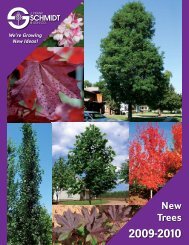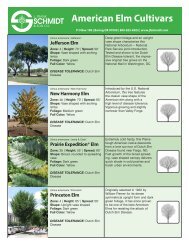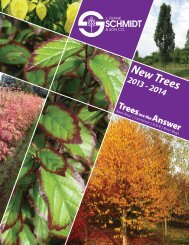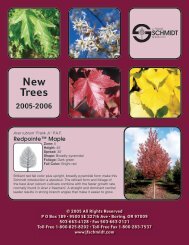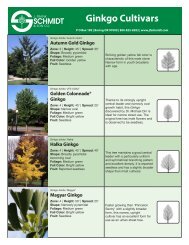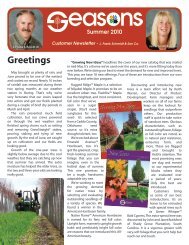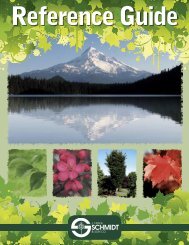Create successful ePaper yourself
Turn your PDF publications into a flip-book with our unique Google optimized e-Paper software.
Our Product Line<br />
Whips<br />
Whips are almost always one-year-old<br />
tops. They range from being completely<br />
unbranched to being lightly branched<br />
on the lower stem. Ash, Mountain Ash,<br />
Linden and Honeylocust will generally<br />
be completely free of branches. Some<br />
Norway Maple varieties often have a<br />
number of branches while others do<br />
not. Red Maples, and to a lesser extent<br />
Sugar Maples and Crabapples, tend to<br />
branch freely off one-year growth. Any<br />
branches above 2 or 2 1 /2 feet from the<br />
ground are left on whips to help increase<br />
caliper and thus provide a sturdier stem.<br />
8'<br />
1-year whip<br />
7 - 8 ft.<br />
Branched Flowering Trees<br />
Hawthorns, Flowering Crabapples<br />
and Cherries are generally 2 year<br />
old trees topped at 4 to 5 feet,<br />
depending on cultivar. A leader is<br />
reestablished by taping. Flowering<br />
Pear and Mountain Ash have a<br />
dominant central leader and branch<br />
well naturally, so are generally<br />
untopped. Head height, symmetrical<br />
branching and straight central<br />
leader create a structural foundation<br />
for a premium quality caliper<br />
tree for the grower, while the heavy branch<br />
structure and full canopy serve the needs of<br />
the garden center.<br />
7'<br />
2-year flowering<br />
6 - 7 ft.<br />
Branched Shade Trees<br />
Varieties including Ash, Birch,<br />
Honeylocust, Linden, Oak, and<br />
some Maple are produced with<br />
a straight central leader and radiating<br />
lateral branches. Varieties<br />
which are not free branching,<br />
such as Norway Maple, Sugar<br />
Maple and Honeylocust, are<br />
topped while dormant to promote<br />
symmetrical branching<br />
during the next growing season.<br />
A single dominant straight leader<br />
is then established by hand<br />
taping the top shoot. Varieties<br />
that branch well are not topped.<br />
In either case, the resulting tree<br />
has a straight leader and<br />
symmetrical branching. In<br />
general, 6 - 8' and 1" - 1 1 /4" grade<br />
trees are two years old. Most<br />
larger sizes are three years old,<br />
possessing fuller heads and more<br />
secondary branching.<br />
14'<br />
2-year<br />
branched<br />
1 - 1 1 /4 ",<br />
8 - 10 ft.<br />
3-year<br />
regular<br />
branched<br />
1 3 /4 - 2",<br />
12 - 15 ft.<br />
10'<br />
Light Branched Trees<br />
These have the same<br />
general form as<br />
branched trees. They<br />
differ in having fewer<br />
and/or shorter branches.<br />
They are often a good,<br />
economical choice for<br />
growers who are lining<br />
out trees, as they have<br />
good sturdiness due to<br />
their caliper, while the<br />
heads are lighter and<br />
will be less likely to fall<br />
over. Growers generally<br />
thin out and prune back<br />
branches when planting,<br />
so this tree can work<br />
well for them. Garden<br />
centers and landscapers<br />
2-year<br />
light branched<br />
1 - 1 1 /4 ",<br />
8 - 10 ft.<br />
3-year light<br />
branched<br />
1 3 /4 - 2",<br />
12 - 15 ft.<br />
may not be happy with light branched trees as<br />
they don’t have the time to let the tree fill out.<br />
10'<br />
14'<br />
© J. <strong>Frank</strong> <strong>Schmidt</strong> & <strong>Son</strong> <strong>Co</strong>.<br />
www.jfschmidt.com<br />
69



